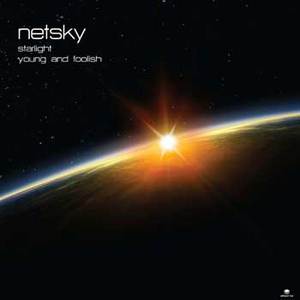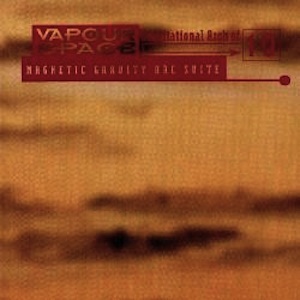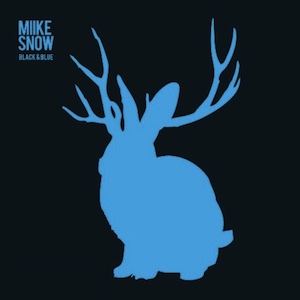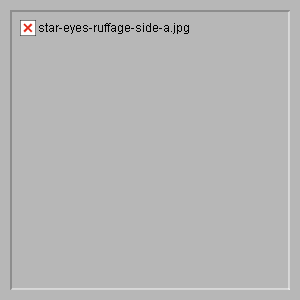tecznotes
Michal Migurski's notebook, listening post, and soapbox. Subscribe to ![]() this blog.
Check out the rest of my site as well.
this blog.
Check out the rest of my site as well.
Dec 30, 2010 6:16pm
blog all oft-played tracks II
Like last year, these are some of the tracks I added to iTunes in 2010 and listened to the most, edited for clarity and minor historical whitewashing.
(Here are the MP3s below as an .m3u playlist)
1. Spoon: Got Nuffin
“Got nuffin’ to lose but darkness and shadows.” Most-played track of the year, from the only normal rock band I consistently spend any time with.
2. Jay-Z: Kingdom Come
I didn’t bump into this until August or so reading back into Ta-Nehisi Coates’s archives, but Kingdom Come might be one my favorite songs this year.
It didn’t take long going down the list before I remembered THE best use of Rick James’ “Superfreak”. Nope, not Hammer. The prize goes to my studio neighbor at Stadium Red, Just Blaze. Really, he flipped the fuck out of that sample for Jay Z’s “Kingdom Come”. I had to hear the song a few times in a row just to figure out, as best I could, the arrangement of it all. … Something he nails really well is giving the song a sort of staccato energy that doesn’t exist at all on the original. I love how the bass line goes from being the focus on the original, to being the fill.
I love this idea of taking pieces of music and dressing them up as something entirely different. It’s old-hat to talk about “sampling” like it’s novel but really Kingdom Come just underscores how hard it is to do well, and how frustrating more obviously sample-driven musicians like Girl Talk can be. You listen to All Day, and you might like it, but in end what you’re left with is a dumb bag of samples dressed in their factory uniforms jostling for your attention, strung one after the other. Ten years on, Z-Trip is still a wedding DJ dusting off the Eurythmics for your amusement, while Kingom Come is closer friends to Orbital’s recombination of Tool or Skinny Puppy’s song-length misappropriation of Roman Polanksi vampire movies (mp3).
Anyway, the other thing I enjoy about Kingdom Come is the use of the studio as a social instrument. Watch Jay-Z and Kanye West working in the studio together, or read about Kanye’s “Hawaii rap-nerd nirvana” for a sense of how art is produced socially both among its producers and between the record and the listener.
3. Venetian Snares: Szamár Madár
Found via David O’Reilly’s Vimeo page and his gorgeous, spooky video for this track.
4. La Roux: Bulletproof
Another song found via the video, this time watched rather than heard on a phone in a restaurant. I love the clarity of La Roux’s voice, and the clinky/jangly pop production on the track.
5. Jamie Woon: Wayfaring Stranger
Spooky, quiet rendition of the old folk song, found via an installment of Electronic Explorations.
6. Netsky: Young And Foolish
7. Hot Chip: I Feel Better
Hot Chip were one of the few live shows I saw this year, at Oakland’s amazing Fox Theater. The video was directed by Peter Serafinowicz (of Look Around You), who says:
I like the idea of taking something we’re all used to seeing—like a boy band music video—and totally destroying it. So I wrote this proposal and included reference images I found on Google—to illustrate the bald guy in the video played by Ross Lee, I used pictures of Mr. Burns from the “X-Files” episode of “The Simpsons”.
I learned there is a boy band tradition—or possibly an actual physical manual—that says you have to have the tough guy, the cute one, the suave one, the one who takes his top off.
8. Vapour Space: Gravitational Arch Of 10
37.752467, -122.418699, 1996-11-17 07:00:00 is the point in spacetime whenwhere I first heard Gravitational Arch Of 10. The sun was already up, and it was one of those things where you think the music is over and then it all rushes back.
9. Miike Snow: Black And Blue (Savage Skulls Remix)
10. Star Eyes: Ruffage (Side A)
This isn’t really a track so much as a 45-minute long mix of drum n’ bass. The MP3 version finally found me this year (thanks Jeremy) after I burned through or lost three separate copies of the cassette over the past fourteen years.
Dec 21, 2010 11:09pm
winter sabbatical 2010: days twelve through sixteen
These posts have drawn somewhat farther apart; this past week has definitely thrown a wrench in my gears. Eric, Shawn and I do a quarterly full-day Stamen partner meeting, and this time we thought it’d be fun to do it down in Palm Springs to celebrate winter. So, down we went on Tuesday and Wednesday last week. Palm Springs is a strange place that rightfully shouldn’t exist, but we still ate two of our meals at the old folks’ country club tennis resort near our hotel. We also managed to squeeze in a visit to the converted 7-11 carniceria/taqueria in Banning that Gem, George, Michele and I found last year on our trip to Joshua Tree. Off the chain, those tacos are.
As you can imagine this hasn’t been a banner week for productive code, research, or design, though I have managed to push a few things out into the world.
(TL;DR*: Skeletron, Oh Yeah, Paper!, Pinboard username mapper)
The first is that my straight skeleton code from last week has a new public home on Github and a new name, Skeletron. Although quite minimal for now, I’ve taken care to ensure that a bare-bones HTTP interface is built right in. You can try it at skeletron.teczno.com:8206. The mnemonic for the port number is the number of bones in the human body. More on all that in a separate post.
The second is a minimal new blog I’ve started, Oh Yeah, Paper, a link-and-picture dump for interesting paper-related things. My research interest in paper is mostly around communication technologies like Mayo Nissen’s City Tickets and easy print-on-demand services used for custom book printing, but there’s plenty of room for silliness as well. I’ve been posting to this site for a bit over a week now, and didn’t want to say anything until after I’d proved to myself that I could keep up a simple daily posting schedule for a little while. We’ll see how that goes.
The big news this week is Yahoo!’s incomprehensible shitcanning of venerable bookmark-sharing service Del.icio.us. This is one of those cases where it’s hard to distinguish malice from stupidity, so I’m grateful to Maciej Ceglowski for having started Pinboard last year. I’ve had an account there since the beginning, and a few weeks ago I started noticing a number of people in my network moving house - James, Aaron, Paul, among many other. Henryk Nyh was kind enough to create a username mapper to speed the transition for folks.
One important outcome of this move has been the sudden interest in baking your own. Jeremy Keith suggests a home-grown Delicious, the “self-hosting-with-syndication way of doing things”. This is largely what I’ve been doing with Delicious for a few years now. I keep the primary copy of my bookmarks in Reblog, and when they’re published I push them to Delicious, Twitter, and my own linkblog. Some of those channels get the tags, some get the full description text, and one just whatever short link and title fragment happens to fit in 140 characters. The elephant in this room is that a primary value of Delicious has always been its network feature, which I use as a primary research tool and general way of finding things I should be paying attention to. Marshall Kirkpatrick wrote a bit about how ReadWriteWeb used the network feature to do research, which meshes pretty well with my own approach. Clearly the social bits were important, something that Jeremy talks about in his post. Stephen Hood (former Delicious product manager) makes the excellent suggestion that the Delicious data corpus be donated, perhaps to the Library of Congress or the Smithsonian. This supports the idea that the data there has value as a historical artifact from 2004-2010, and especially well with Twitter’s corresponding donation of public tweets to the LOC. Twenty years down the line, looking at those two datasets in concert is going to lead to some fascinating research.
There have also been a bunch of responses to the problematic idea that it’s possible to bang out your own alternative service, maybe best expressed by Andre Torrez in How To Clone Delicious in 48 Hours:
You may have heard that Delicious is shutting down (or not?). Someone on Twitter suggested that a group of engineers should get together on a weekend and build a Delicious clone. In anticipation of this mystery group of people sitting down and doing this, I thought I'd make a quick todo list for them.
Andre continues with a laundry list of social features like account systems, imports, tags, etc. Jeff Atwood has a similar post on the difficulties of sending email from code. While both of these guys are clearly accomplished developers, I think they’re expressing a little too much stop energy for my comfort. Andre lists a number of “critical” features that Pinboard is cheerfully lacking right now, and Jeff is ignoring the presence of services like AuthSMTP and Spam Arrest offering completely brainless SMTP for not very much money. While you wouldn’t build something huge on top of these services, it’s worth remembering that Delicious started life as a text file, and grew into its present form over time. Things start tiny and develop direction over time as user-constituents suggest ideas or push and pull the service in new directions. There is still a lot of good you can do online with plain old flat files, and even Twitter was able to get a useful, fun service built on quicksand.
Any product that includes a community component is a vector rather than a point: there’s where you started, and the possible gulf between where you think you’re going and where your constituents think you’re going.
Anyway.
Dec 14, 2010 4:52am
winter sabbatical 2010: days eight, nine, ten, and eleven
I spent days eight and nine in Chicago. Walking Papers is up in all its crinkly glory at the Chicago Art Institute, in the Hyperlinks exhibit thanks to curator Zöe Ryan. Eric, Geraldine, and intern Martha Pettit arranged a selection of submitted scans over a twelve foot wall. It was bitterly cold, and I thought I’d do a much better job of getting out and about without being quite prepared for the reality of weather. Adrian, Paul, and the gang at Everyblock kindly offered a bit of couch space at their northside office for me to lounge on during day nine, and when I left I saw a tiny rabbit cross my path in the snow. I’m told that’s normal - “lots of friendly squirrels and bunnies in Chicago.”
Day ten was travel, and movies, and general laziness. I launched the Atlas feature of Walking Papers, which you can see if you compose a new scan on the front page. You get back a multi-page PDF; nothing special but the possibility of using these to distribute assignments to a group is something I’ve been planning for. Since I last mentioned it, the Random Hacks Of Kindness TaskMeUp project popped onto my radar - it seems to be built around some of the same ideas, aiming for the world of humanitarian and crisis response.
The thing that really ate my head for the past few days has been a computational geometry technique called the straight skeleton. The short story is that it’s a way to simplify polygons down to lines with special applications for cartography. The long story is that I have a personal history of letting what Aaron calls “mathshapes” consume me for days on end, and this is the latest example. Some people have knitting, crossword puzzles, gambling, or crack. I have geometry, and my biggest personal challenge during a fairly open-ended sabbatical like this one has been to ensure that when even whean heading down blind alleys, there’s a plan for sharing the results.
Anyway, this is a simplified illustration (from my State Of The Map U.S. conferences slides) that shows how the use of buffers, polygons, and the straight skeleton can be used to convert OpenStreetMap road data into improved, more easily-labeled lines:
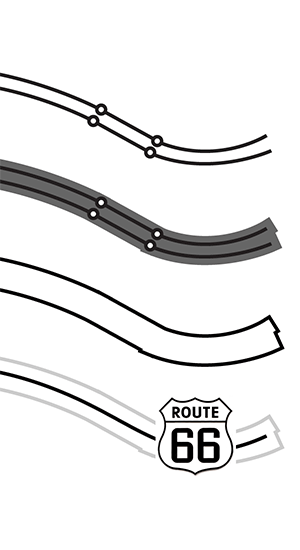
As I mentioned in my NACIS keynote last year, OpenStreetMap has a fairly specific range of scales where it’s designed to work best, and if you need to create a lower-zoom map you will find that details like dual carriageways (large roads and freeways split into parallel strips) and interruptions for bridges or tunnels make it incredibly hard to generate good looking labels, not to mention the issue of publishing raw data in a useful or compressed form. While deriving the skeleton of a shape is perfect for this problem, there’s not a lot out there in the way of accessible implementations of the algorithm. OpenStreetMap has no current answer to the idea of derived, lower-resolution datasets outside the very low-resolution Natural Earth collection. OSM is historically biased toward manual production, and Steve Coast has advised me that setting up lower resolution OSM servers for manual tracing might be a more sensible way to handle this unmet need. I do agree, though computed geometries offer an excellent leg up to solve the cold start problem somewhat.
So, I blew through two days reading through implementation notes and doing a bit of coding, starting from Tom Kelly’s java implemetation Campskeleton. I’m not a java programmer, but Kelly’s straight skeleton index page offers plenty of notes on how to actually get the thing built. Most important are a few late-90s academic papers: Raising Roofs, Crashing Cycles, Playing Pool by David Eppstein and Jeff Erickson and especially Straight Skeleton Implementation by Petr Felkel and Štěpán Obdržálek, along with the cartography-specific approach from Using the Straight Skeleton for Generalisation in a Multiple Representation Environment.
Anyway, here’s where I’ve gotten to:

The easiest way to think of the straight skeleton is as a peaked roof on a building. Starting with the gutters of an arbitrarily-shaped building, you build up sloping roof until the bits all meet in the middle. The ridge of roof all the way around is the skeleton, and it gives a pretty good idea of the building’s axis, or a path it follows.

That angular blob might not look like a map, but imagine it as a curving road. Here’s what I’m aiming for, more generally:
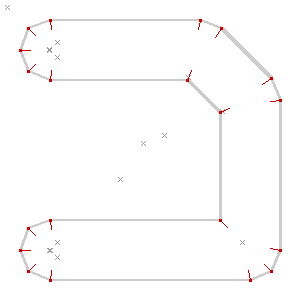
The idea is similar in spirit to Paul Ramsey’s simplified Vancouver Island. There are a bunch of pitfalls in the process. Here’s one from before I figured out how to correctly order the priority list of roof line intersections, and didn’t check that points were actually inside the containing polygon:
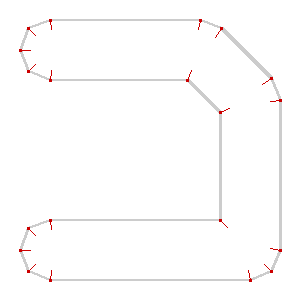
Here’s an example showing an imaginary dual carriageway, buffered out to merge the shapes into a single polygon and then skeletonized down the middle:

The algorithm is incredibly sensitive to initial conditions, such as this example where a few extra parallel lines result in a double-peaked roof. It’s a plausible overhead view of a building, and a correct skeleton, but not quite the thing for cartography:
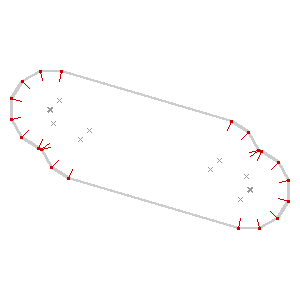
It’s also worth noting that I’m not doing anything to detect collisions just yet:
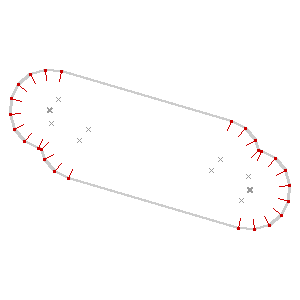
I’m getting close to done with this alley. The particular needs I’m aiming at are largely connected to the book-based bicycle map I described last time. It’s possible now to render excellent maps from OSM, but the medium of print makes small errors much more glaring, and I’m interested in fixing some of the loose ends of cartographic representation and OpenStreetMaps.
So, math shapes.
Dec 8, 2010 11:07pm
winter 2010 sabbatical: days four, five, six, and seven
It’s been almost a full week since my previous sabbatical update. Where was I? Oh right, maps. I’ve been making progress on two fronts: one is a series of updates to Walking Papers, the other is the a print project that currently lacks a name. The Wikileaks affair has also been completely engrossing, more on that below.
As I described last week, Walking Papers will have a multi-page atlas feature Real Soon Now, probably within a few days. I’ve been using the opportunity to improve the overall quality of the print and scan production process and also moved the whole site from its previous home on my overburdened Pair.com shared hosting account to a fresh new Linode instance. I’m also doing a fair bit of behind-the-scenes work on the scan decoding process, which I’m embarrassed to say has been riddled with problems from day one. The SIFT-driven corner-finding process has never been a major issue, but a lot of scans seem to fail because the QR Code reading library (Google’s Zxing) often can’t find a message in an image that’s nothing but crisp, isolated, beautiful code. I don’t know enough about the internals of Zxing to fix the problem there, but I can insert a manual step to allow people to simply type in the address contained in the code in the event of a read failure. Boring, but necessary. The other bit of sub-surface work I’m starting on is the ability to use a normal digital camera to read back the scans, hopefully with U.C. Berkeley’s Sarah Van Wart and prompted by Ushahidi’s Patrick Meier. Sarah has used the project to great effect with Richmond High School students and Patrick knows from firsthand experience how much of a pain it can be to find a scanner while everyone’s got cameraphones in their pockets.
The other print project is something I’m collaborating on with my friends Adam Schwarcz and Craig Mod, bicycle-enthusiast and book-maker respectively. It’s a long-time-in-the-works bicycle map of San Francisco and Oakland based on government data and OpenStreetMap, with a barcode-driven print/digital connection that we’re still brainstorming about. This was only my second exploration in the area of data-driven automatic print design when Adam first suggested the idea last year, but I’ve had enough experience with talking paper in the intervening time that I’m using my sabbatical to jump back into the project. Look for more on this in the next few weeks.
Alon Salant over at Carbonfive was gracious enough to offer a desk for a few days, and while working on these various projects I’ve also had a privileged view on what an agile workplace looks like. It’s been fascinating to observe from inside a development process that seems built around conversation, and while camped out at a loaner desk in their 2nd St. office I heard the beating heart of design and technical arguments that I’m more accustomed to experiencing via text.
At the moment I’m in Chicago, in what the bellhop (bellhop!) tells me is Al Capone’s old dentist’s office. Need to buy gloves, eat, and then head to the Art Institure where Walking Papers is part of the Hyperlinks exhibit.
Meanwhile, Uptown...
This week, I am helplessly transfixed by the Wikileaks story. There’s so much meat to this unfolding event, well-covered so far by Andy Baio’s Cablegate roundup. What’s really caught my interest has been the reactions of businesses like Amazon, Paypal, Mastercard, and Visa - all supposedly independent businesses suddenly acting in concert to isolate and marginalize a strange new actor. The timing of the response suggests that it wasn’t triggered by the release of the diplomatic cables at all, but rather by Julian Assange’s promise to release future documents related to the activity of an unnamed major bank. It’s like Naked Lunch, a moment when time grinds to a halt and you can see what’s sitting on everyone’s fork as they raise it from their plate. Hypothetical arguments about the likelihood of cloud data providers like Amazon or payment processors like Paypal cutting connections evaporate instantly: here is a clear-cut example of a inconvenient release of information scaring the shit out of someone enough to apply the screws.
Assange’s past writings about conspiracies and invisible governments painted a picture that was too large and too diffuse to elicit a local reaction. A conspiracy as subtle and far-reaching as that described by Assange might not be worth reacting to, because how can it be distinguished from simple alignment of interests? How can a private individual successfully act in response? Here, though, we see pieces of the whole suddenly illuminated as by a camera flash: milquetoast diplomatic chatter causes Amazon to suddenly decide that it cannot abide the hosting of unauthorized material. A strangely-timed sexual assault charge leads to an unprecedented Interpol warrant for Assange’s arrest. Senators and congressmen opine that if pursuing Wikileaks is difficult under the law we have, then perhaps we might look into changing the law?
The decision to leak a stream of diplomatic cables (as opposed to any one particular cable) is a sharp departure from typical journalistic approaches, which is really what I’m finding so engrossing in this story. Yesterday on the radio, a former general counsel of the C.I.A. complained that the released data lacked a “patina of journalism” or an editorial function (and therefore did not qualify for constitutional protection), which suggests to me that the government is now actually quite comfortable with the occasional fallout of the shocking revelations of journalism-as-usual. Even sustained evidence of state-run torture and of course that fucking war hasn’t led to the breadth and depth of reaction we’re seeing now: “All hands, fire as they bear.” Why now? The amusing dullness of the leaked cables shows that Wikileaks has decided to hunt upstream, taking aim at the metabolic processes of communication and secrecy. If there is in fact a conspiracy, and this is how it talks to itself, maybe we play a few games with its own internal communications to see what happens?
What’s currently happening is that all sorts of actors are responding in unexpected ways. Like a meadow crossed with underground gopher tunnels, Amazon’s reaction suggests that at least a few widely-separated individuals are in fact quite deeply connected and spooked enough to show themselves above ground in surprising places. Maybe a simple response is that I take our (four-figure per month) Amazon Web Services business to a competing cloud provider? Maybe another is that I route around Paypal in the future? On the other hand, how could I conceivably avoid Mastercard and Visa? Hopefully, Julian Assange is what he says he is: a spokesman and intentional fall-guy for a much larger group that can act without him.
Meanwhile, I’ve got my bowl of popcorn sitting here and it’s looking like a fascinating ride.
Dec 2, 2010 8:55am
winter 2010 sabbatical: days two and three
Two days have elapsed, all is well.
Yesterday I spent most of my morning dragging the six month-old “Atlas” feature of Walking Papers into a releasable state. It’s not quite there yet, but it’s significantly closer than the one I bashed together in a few days at a Camp Roberts exercise back in April. The general idea behind this feature is that the single-sheet bias of Walking Papers is a hindrance to people covering large areas, and more significantly it doesn’t help people who are delegating work. I continue to be surprised at the outcomes of this project - Eric is more focused on the tactile and aesthetic qualities of the prints themselves, while I’m interested in some of the social and organizational implications. It was always designed to be personal and utilitarian, but we’re finding that in a lot of ways it’s not quite those two things, not necessarily at the same time. Socially, the idea of multiple-page outputs opens the dynamic of tasking or assignment, which turns the sheet of paper into a communicating object. Why should it necessarily be the same person choosing the area, printing everything, handing out maps, noting down features, running them back and doing the scanning? Properly organized, all those activities can be parceled out and done more effectively for large areas.
An important thing that happened was the release of Bing imagery for tracing into OpenStreetMap, one of the most visible outcomes of Steve Coast’s new job over there. Also, the OSM Flash-based editor Potlatch 2 was finally released into the wild. Something really significant is happening with OpenStreetMap right now - it’s hitting all these critical communities and corporations and sparks and ripples are shooting out.
Today I spent most of the day catching up with Stamen alumni Ben Cerveny and Tom Carden, and working on a little thing we’re developing with Adam Greenfield and Nurri Kim over at Do Projects. It’s hiding in plain sight, I’ll talk more about it later when I’m more comfortable that we’re close to release.
Also, mostly thanks to Aaron, I pinned a bunch of new cartography porn:





